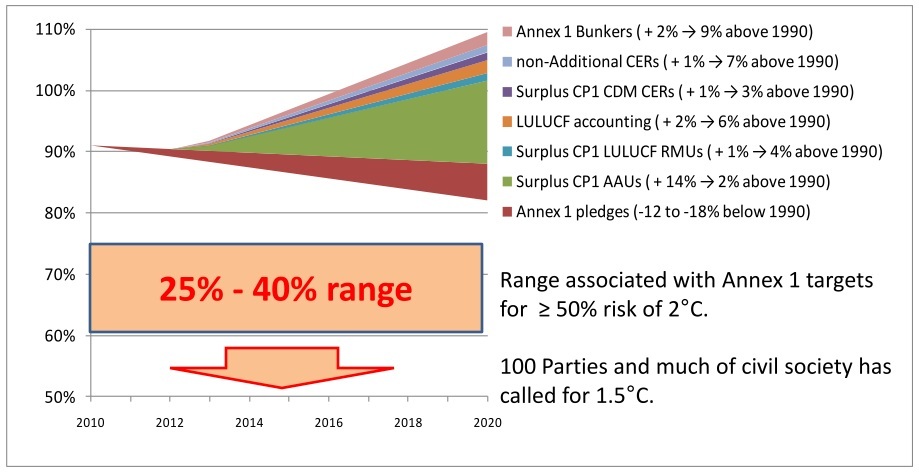The bad news is that the climate/energy push just crashed and burned in the Senate. The good news is that, in the wake of that crash, the U.S. climate community is having a Big Think, one of the best in years. The last time we had such an exchange was back after what, for lack of a better term, I will call the Copenhagen Disappointment. Which raises an interesting question — do we only debate, openly and seriously, after we lose?
Maybe soon, it’ll no longer take a major loss to move us to frank public debate about fundamental things. Anyway, judging by the situation in Bonn, where a terminally inconclusive post-Copenhagen “intercessional” just shambled a bit closer to December’s rematch in Cancun, we’re going to get another disappointment soon enough. So stand ready. If the usual pattern holds, the next round of recrimination — a global round — will start in early December.
At least we can now see the writing on the wall. Hell, here in the U.S., our face is pressed right up against it. And, internationally, thanks to a recent series of reports, we know just how intolerable the post-Copenhagen status quo really is.
To recap: the climate movement hasn’t even been able to agree that Copenhagen was a failure. This is because the last-minute “Copenhagen Accord” — though widely and justly disparaged — has actually moved the world’s nations to commit pledges to paper. The significance of this move was widely underappreciated in the bitter months just after Copenhagen, but now that it’s a fact on the ground, things are changing. Bottom line: the Copenhagen Accord sets up a “transparent” situation in which research teams around the world can sum and evaluate both the total size of the global emissions reduction pledge, and the total size of the Annex 1 (rich world) pledge.
Alas, both are terribly low — not only with respect to the demands of the 1.5 and 2 degrees C temperature targets that constitute our best hope for survival, but also with respect to the oft-supported (even by the IPCC) claim that, to hold the 2 degrees line, the Annex 1 countries must reduce emissions, by 2020, to by at least 25 percent, and preferably 40 percent, below their 1990 levels. And if (like over 100 countries and most all the global climate movement) they want to hold the warming to 1.5 C, they support even larger cuts. The problem is that Annex 1’s “aggregate pledges” add up to cuts of only 17-25 percent below 1990 levels by 2020, and that’s before you account for the U.S.’s pledge (which is explicitly still on the table) to reduce emissions by 17 percent below the 2005 level by 2020. The pledge, it turns out, is almost as paltry as it is unacceptable to the American right. Factor it in and you dilute the total rich-world 2020 pledge down to 12-18 percent below 1990.
Does this seem a large number? Perhaps in Washington, though it’s still entirely inadequate, given what it implies for the weak ambition of the overall global regime. But what if we, as they say, get realistic? Would it not at least be a break with the past, and maybe, just maybe, enough to get the ball rolling?
The problem is that the ball only rolls if the pledges perform as advertized. And this, as it turns out, is not the plan. Because the Copenhagen pledges, though widely trumpeted by governments around the world, are rife with loopholes.
The mere existence of such loopholes is not news — bogus land-use emissions accounting, non-additional offsets, “hot air” from the former Society states, “bunker” emissions associated with international travel and shipping — the climate NGOs have been talking about them for years, to anyone who would listen. What is news is that, now that the science is clear (see for example Mitigating climate change through reductions in greenhouse gas emissions: is it possible to limit global warming to no more than 1.5 degrees C?, by the U.K.’s Grantham Research Institute on Climate Change and the Environment, Centre for Climate Change Economics and Policy, and Hadley Centre) and the pledges have been collected by the U.N. Secretariat, the total size of the Annex 1 loophole can be properly evaluated. And, according to a series of recent accountings — one, by Sivan Kartha of the Stockholm Environment Institute, presented at a UNFCCC workshop in Bonn (described in this excellent summary by the Third World Network), and another, The Integrity Gap: Copenhagen Pledges and Loopholes, published by Simon Terry at the Sustainability Council of New Zealand — it’s, well, huge.
In fact, even when conservative assumptions are used, the Copenhagen pledges contains so many loopholes that, taken together, they sum to 21 percent of 1990 emissions, a number that entirely negates the pledges themselves! So that the official, well-publicized global 2020 emissions reductions target of 12-18 percent actually means that emissions levels large enough to reach 3-9 percent above 1990 would be allowed. Which is (a technical point but one that climate wonks will appreciate) actually more than the business-as-usual projection!
Here’s a picture, from Kartha’s presentation in Bonn:

It’s a grim situation. But at the same time, it’s an interesting one. Because the cat is out of the bag. The rich world’s negotiating position is bankrupt. And we know it, though only painfully, as we also know that even the strained realism of Obama-era climate policy has been unable to move the U.S. Senate. As we know that, in its stasis, the U.S. goes a long way towards paralyzing the rest of the world. And that this paralysis is extremely convenient, to recalcitrant elites everywhere.
Still, the situation is quite unstable. Look again at the top of Kartha’s graph, and know that we’re probably not going to ride up that puce line, not the way the science is going, not without a legitimation crisis of major proportions! And because we won’t, we’re going to do something new. Exactly what in it will be is not clear at the moment, but I at least have found an odd balm in the current U.S. debate. I particularly like Dave Robert’s analysis — that the real problems are the Senate and the economic crisis, and that our policy disputes are secondary. And Bill McKibben’s, because it tell us that, as a matter of strategy, we must tell the truth — “we have to ask for what we actually need, not what we calculate we might possibly be able to get.” Taken together, I read them to imply that we have both an opportunity and a responsibility to speak freely.
Even I, with my left-green beliefs about how global economic justice is a precondition for a viable global climate regime, even I am free to speak my mind, without worrying that I’ll squirrel the deal for my realist friends in Washington. True, I have to be careful about how I talk about costs (as in the aggregate global cost of saving our civilization, which, frankly, is going to be a bit high), but beyond that I can relax. Today’s Republicans already believe, or claim to believe, that environmentalism = socialism = the U.N. = dictatorship, and that Sweden is Hell on Earth. Given this, how much harm can it possible do to add one more small wrinkle to the mix — like a frank discussion of the impasse
in the global negotiations?


